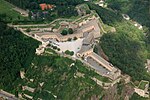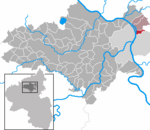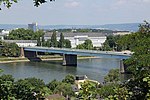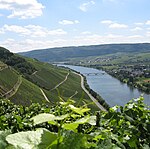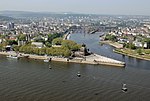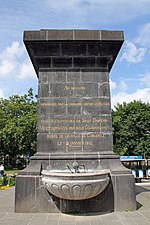Between Bingen and Bonn, Germany, the river Rhine flows as the Middle Rhine (German: Mittelrhein, pronounced [ˈmɪtl̩ˌʁaɪn] (listen)) through the Rhine Gorge, a formation created by erosion, which happened at about the same rate as an uplift in the region, leaving the river at about its original level, and the surrounding lands raised. This gorge is quite deep, about 130 metres (430 ft) from the top of the rocks down to the average water-line.
The "Middle Rhine" is one of four sections (High Rhine, Upper Rhine, Middle Rhine, Lower Rhine) of the river between Lake Constance and the North Sea. The upper half of the Middle Rhine (Rhine Gorge) from Bingen (Rhine-kilometer 526) to Koblenz (Rhine-kilometer 593) is a UNESCO World Heritage Site as a striking cultural landscape with more than 40 castles and fortresses from the Middle Ages, unique terraced vineyards, and many wine-villages. The lower half from Koblenz (Rhine-kilometer 593) to Bonn (Rhine-kilometer 655) is famous for the formerly volcanic Siebengebirge with the Drachenfels volcano. Both parts together are known as "the romantic Rhine".
The Middle Rhine Valley has been a major tourist attraction since the 19th century. It is also home to some 450,000 people. The valley owes its special appearance to both its natural shape and human alterations. For two millennia, it has been one of the most important routes for cultural exchange between the Mediterranean region and northern Europe. Situated in the heart of Europe, it was sometimes a border and sometimes a bridge between different cultures. The history of the valley reflects the history of Western Europe. With its many outstanding monuments, its hills full of vines, its settlements crowded on the narrow river banks, and the rows of castles lined up on the hill tops, it is considered the epitome of the Rhine romanticism. It inspired Heinrich Heine to write his famous poem "Lorelei" and Richard Wagner to write his opera Götterdämmerung.
The vineyards along the Middle Rhine form the wine-growing region of the same name, see Mittelrhein (wine region).

